coolant temperature GENESIS G80 2017 Owner's Manual
[x] Cancel search | Manufacturer: GENESIS, Model Year: 2017, Model line: G80, Model: GENESIS G80 2017Pages: 496, PDF Size: 12.82 MB
Page 150 of 496
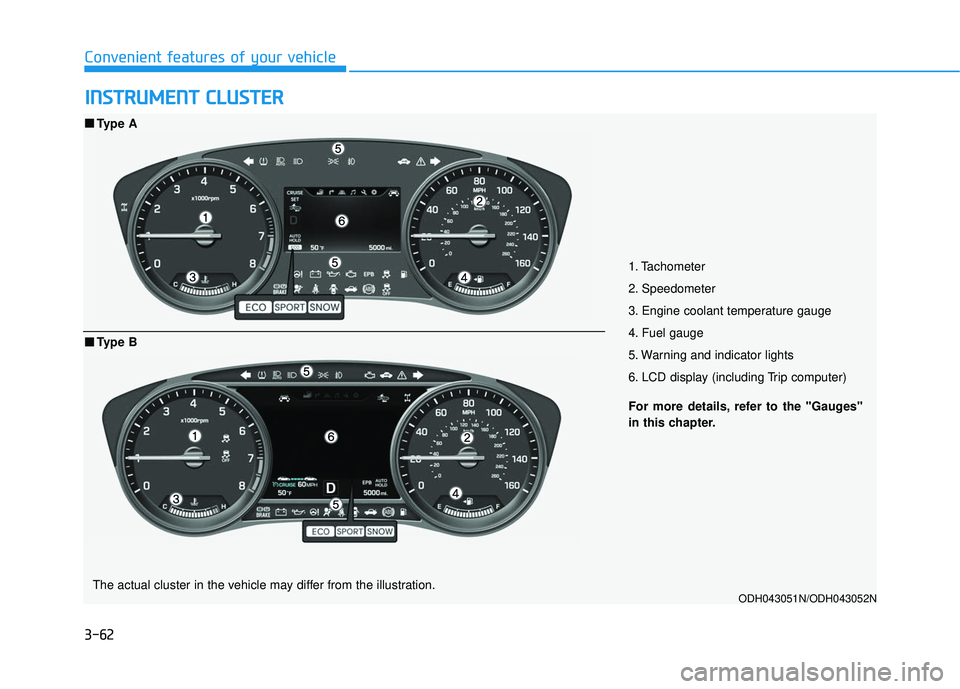
3-62
Convenient features of your vehicle
I
IN
N S
ST
T R
R U
U M
M E
EN
N T
T
C
C L
LU
U S
ST
T E
ER
R
1. Tachometer
2. Speedometer
3. Engine coolant temperature gauge
4. Fuel gauge
5. Warning and indicator lights
6. LCD display (including Trip computer)
ODH043051N/ODH043052N
■ ■
Type A
For more details, refer to the "Gauges"
in this chapter.
■ ■Type B
The actual cluster in the vehicle may differ from the illustration.
Page 153 of 496
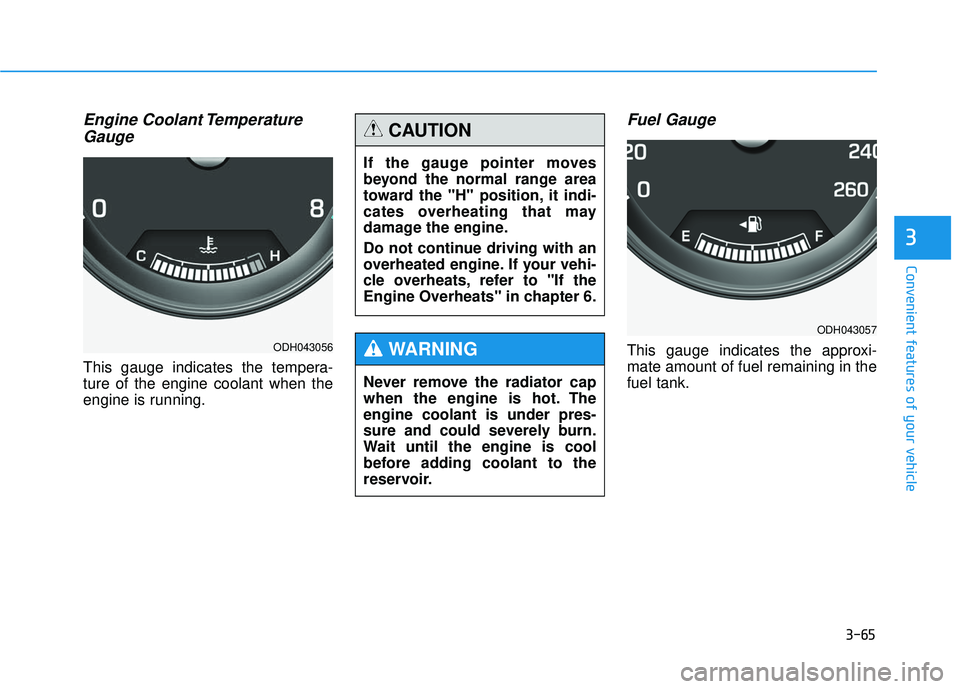
3-65
Convenient features of your vehicle
3
Engine Coolant TemperatureGauge
This gauge indicates the tempera-
ture of the engine coolant when the
engine is running.
Fuel Gauge
This gauge indicates the approxi-
mate amount of fuel remaining in the
fuel tank.ODH043056
If the gauge pointer moves
beyond the normal range area
toward the "H" position, it indi-
cates overheating that may
damage the engine.
Do not continue driving with an
overheated engine. If your vehi-
cle overheats, refer to "If the
Engine Overheats" in chapter 6.
CAUTION
Never remove the radiator cap
when the engine is hot. The
engine coolant is under pres-
sure and could severely burn.
Wait until the engine is cool
before adding coolant to the
reservoir.
WARNING
ODH043057
Page 298 of 496

5-43
Driving your vehicle
5
When Active ECO is activated:
The acceleration response may beslightly reduced as the accelerator
pedal is depressed moderately.
The air conditioner performance may be limited.
The shift pattern of the automatic transmission may change.
The engine noise may get louder.
The above situations are normal
conditions when the Active ECO sys-
tem is activated to improve fuel effi-
ciency. Limitation of Active ECO opera-
tion:
If the following conditions occur while
Active ECO is operating, the system
operation is limited even though
there is no change in the ECO indi-
cator.
When the coolant temperature is
low:
The system will be limited until
engine performance becomes nor-
mal.
When driving up a hill: The system will be limited to gain
power when driving uphill because
engine torque is restricted.
When using the automatic trans- mission Sports mode:
The system will be limited accord-
ing to the shift location.SPORT mode
SPORT mode focuses ondynamic driving by auto-
matically controlling the
steering wheel, engine
and transmission system.
When the DRIVE MODE switch is pressed and the SPORT mode is
selected, the SPORT indicator
(yellow) will illuminate.
When the SPORT mode is activat- ed, and the engine is turned off
and on it will change to NORMAL
mode. To turn on the SPORT
mode, press the DRIVE MODE
switch again.
If the system is activated: - After accelerating and releasingthe accelerator pedal, the gear
and engine speed RPM may not
drop as soon as in NORMAL
mode.
- Up-shifting is delayed.
✽ ✽ NOTICE
In SPORT mode, the fuel efficiency
may decrease.
SPORT
Page 359 of 496

6-7
What to do in an emergency
6
If your temperature gauge indicates
overheating, you experience a loss
of power, or hear loud pinging or
knocking, the engine may be over-
heating. If this happens, you should:
1.Pull off the road and stop as soonas it is safe to do so.
2.Place the shift lever in P (Park) and set the parking brake. If the air con-
ditioning is ON, turn it OFF.
3.If engine coolant is running out under the vehicle or steam is com-
ing out from the hood, stop the
engine. Do not open the hood until
the coolant has stopped running or
the steaming has stopped. If there
is no visible loss of engine coolant
and no steam, leave the engine
running and check to be sure the
engine cooling fan is operating. If
the fan is not running, turn the
engine off. 4.Check for coolant leaking from the
radiator, hoses or under the vehi-
cle. (If the air conditioning had
been in use, it is normal for cold
water to be draining from it when
you stop.)
5.If engine coolant is leaking out, stop the engine immediately and
call the nearest authorized
HYUNDAI dealer for assistance.
I IF
F
T
T H
H E
E
E
E N
N G
GI
IN
N E
E
O
O V
VE
ER
R H
H E
EA
A T
TS
S
While the engine is
running, keep hands,
clothing and tools
away from the mov-
ing parts such as the
cooling fan and drive
belt to prevent seri-
ous injury.
WARNING
Page 360 of 496
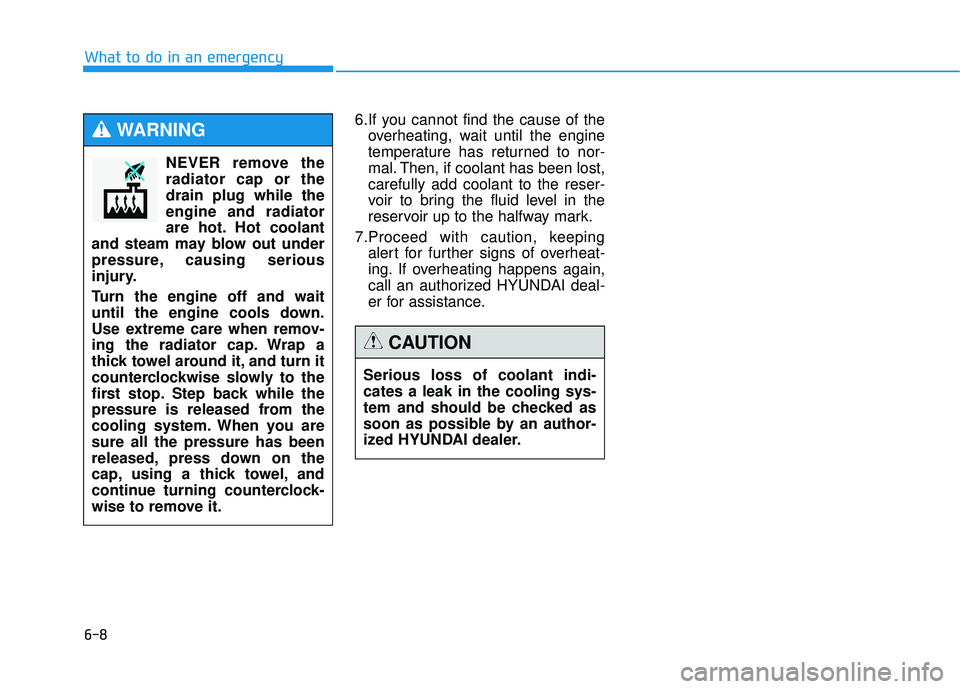
6-8
What to do in an emergency6.If you cannot find the cause of theoverheating, wait until the engine
temperature has returned to nor-
mal. Then, if coolant has been lost,
carefully add coolant to the reser-
voir to bring the fluid level in the
reservoir up to the halfway mark.
7.Proceed with caution, keeping alert for further signs of overheat-
ing. If overheating happens again,
call an authorized HYUNDAI deal-
er for assistance.
Serious loss of coolant indi-
cates a leak in the cooling sys-
tem and should be checked as
soon as possible by an author-
ized HYUNDAI dealer.
CAUTION
NEVER remove the
radiator cap or the
drain plug while the
engine and radiator
are hot. Hot coolant
and steam may blow out under
pressure, causing serious
injury.
Turn the engine off and wait
until the engine cools down.
Use extreme care when remov-
ing the radiator cap. Wrap a
thick towel around it, and turn it
counterclockwise slowly to the
first stop. Step back while the
pressure is released from the
cooling system. When you are
sure all the pressure has been
released, press down on the
cap, using a thick towel, and
continue turning counterclock-
wise to remove it.
WARNING
Page 407 of 496

7-30
Maintenance
The electric motor for the cooling fan
is controlled by engine coolant tem-
perature, refrigerant pressure and
vehicle speed. As the engine coolant
temperature decreases, the electric
motor will automatically shut off. This
is a normal condition. If your vehicle
is equipped with GDI, the electric
motor for the cooling fan may begin
to operate at any time and continue
to operate until you disconnect the
negative battery cable. Check the condition and connections
of all cooling system hoses and
heater hoses. Replace any swollen
or deteriorated hoses.
The coolant level should be filled
between the F and the L marks on
the side of the coolant reservoir
when the engine is cool.
If the coolant level is low, add enough
distilled (deionized) water to bring
the level to the F mark, but do not
overfill. If frequent additions are
required, we recommend that you
see an authorized retailer of Genesis
Branded products for a cooling sys-
tem inspection.
Recommended engine coolant
When adding coolant, use only
deionized water, distilled water or
soft water for your vehicle and
never mix hard water in the coolant
filled at the factory.
An improper coolant mixture can result in severe malfunction or
engine damage.
The engine in your vehicle has alu- minum engine parts and must be
protected by an ethylene-glycol-
based coolant to prevent corrosion
and freezing.
Do not use alcohol or methanol coolant or mix them with the spec-
ified coolant.
Do not use a solution that contains more than 60% antifreeze or less
than 35% antifreeze, which would
reduce the effectiveness of the
solution.
The electric motor for
the cooling fan may
continue to operate
or start up when the
engine is not running
and can cause serious injury.
Keep hands, clothing and tools
away from the rotating fan
blades of the cooling fan.WARNING
ODH073004
Page 408 of 496
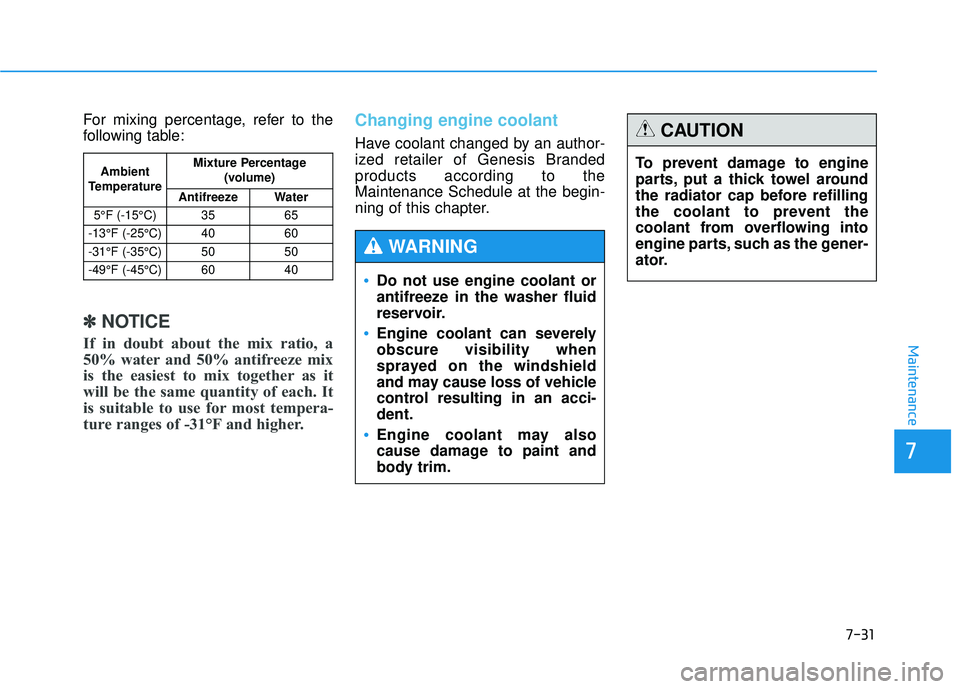
7-31
7
Maintenance
For mixing percentage, refer to the
following table:
✽ ✽NOTICE
If in doubt about the mix ratio, a
50% water and 50% antifreeze mix
is the easiest to mix together as it
will be the same quantity of each. It
is suitable to use for most tempera-
ture ranges of -31°F and higher.
Changing engine coolant
Have coolant changed by an author-
ized retailer of Genesis Branded
products according to the
Maintenance Schedule at the begin-
ning of this chapter.
Ambient
Temperature Mixture Percentage
(volume)
Antifreeze Water
5°F (-15°C) 35 65
-13°F (-25°C) 40 60
-31°F (-35°C) 50 50
-49°F (-45°C) 60 40
Do not use engine coolant or
antifreeze in the washer fluid
reservoir.
Engine coolant can severely
obscure visibility when
sprayed on the windshield
and may cause loss of vehicle
control resulting in an acci-
dent.
Engine coolant may also
cause damage to paint and
body trim.
WARNING
To prevent damage to engine
parts, put a thick towel around
the radiator cap before refilling
the coolant to prevent the
coolant from overflowing into
engine parts, such as the gener-
ator.
CAUTION
Page 472 of 496

7-95
7
Maintenance
Canister
Fuel vapors generated inside the fuel
tank are absorbed and stored in the
onboard canister. When the engine is
running, the fuel vapors absorbed in
the canister are drawn into the surge
tank through the purge control sole-
noid valve.
Purge Control Solenoid Valve(PCSV)
The purge control solenoid valve is
controlled by the Engine Control
Module (ECM); when the engine
coolant temperature is low during
idling, the PCSV closes so that evap-
orated fuel is not taken into the
engine. After the engine warms-up
during ordinary driving, the PCSV
opens to introduce evaporated fuel to
the engine.
3. Exhaust emission control system
The Exhaust Emission Control
System is a highly effective system
which controls exhaust emissions
while maintaining good vehicle per-
formance.
When the engine starts or fails to
start, excessive attempts to restart
the engine may cause damage to the
emission system.
Vehicle modifications
This vehicle should not be modi-
fied. Modification of your vehicle
could affect its performance, safety
or durability and may even violate
governmental safety and emis-
sions regulations.
In addition, damage or performance
problems resulting from any modifi-
cation may not be covered under
warranty.
If you use unauthorized electronic devices, it may cause the vehicle to
operate abnormally, wire damage,
battery discharge and fire. For your
safety, do not use unauthorized
electronic devices.
Engine exhaust (carbon monox-ide) precautions
Carbon monoxide can be present
with other exhaust fumes. If you
smell exhaust fumes of any kind in
your vehicle, drive with all the win-
dows fully open. Have your vehicle
checked and repaired immediately.
Engine exhaust gases contain
carbon monoxide (CO). Though
colorless and odorless, it is
dangerous and could be lethal if
inhaled. Follow the instructions
on this page to avoid CO poi-
soning.
WARNING
Page 490 of 496
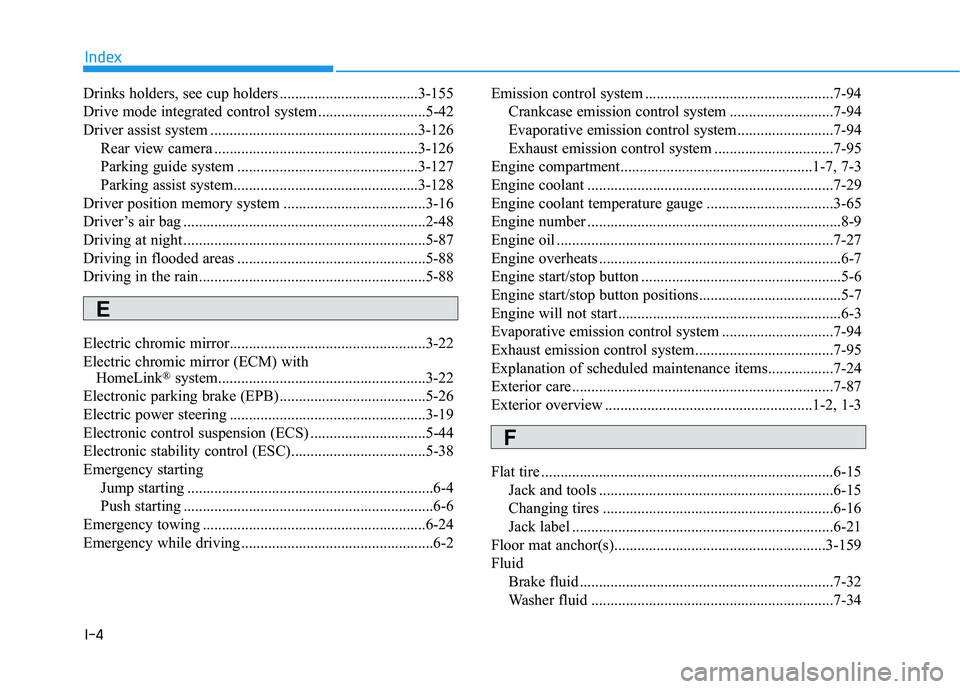
I-4
Drinks holders, see cup holders ....................................3-155
Drive mode integrated control system ............................5-42
Driver assist system ......................................................3-126Rear view camera .....................................................3-126
Parking guide system ...............................................3-127
Parking assist system................................................3-128
Driver position memory system .....................................3-16
Driver’s air bag ...............................................................2-48
Driving at night ...............................................................5-87
Driving in flooded areas .................................................5-88
Driving in the rain...........................................................5-88
Electric chromic mirror...................................................3-22
Electric chromic mirror (ECM) with HomeLink
®system......................................................3-22
Electronic parking brake (EPB) ......................................5-26
Electric power steering ...................................................3-19
Electronic control suspension (ECS) ..............................5-44
Electronic stability control (ESC)...................................5-38
Emergency starting Jump starting ................................................................6-4
Push starting .................................................................6-6
Emergency towing ..........................................................6-24
Emergency while driving ..................................................6-2 Emission control system .................................................7-94
Crankcase emission control system ...........................7-94
Evaporative emission control system .........................7-94
Exhaust emission control system ...............................7-95
Engine compartment..................................................1-7, 7-3
Engine coolant ................................................................7-29
Engine coolant temperature gauge .................................3-65
Engine number ..................................................................8-9
Engine oil ........................................................................\
7-27
Engine overheats ...............................................................6-7
Engine start/stop button ....................................................5-6
Engine start/stop button positions.....................................5-7
Engine will not start..........................................................6-3
Evaporative emission control system .............................7-94
Exhaust emission control system....................................7-95
Explanation of scheduled maintenance items.................7-24
Exterior care....................................................................7-87\
Exterior overview ......................................................1-2, 1-3
Flat tire ........................................................................\
....6-15 Jack and tools .............................................................6-15
Changing tires ............................................................6-16
Jack label ....................................................................6-21\
Floor mat anchor(s).......................................................3-159
Fluid Brake fluid ..................................................................7-32
Washer fluid ...............................................................7-34
Index
E
F
Page 491 of 496
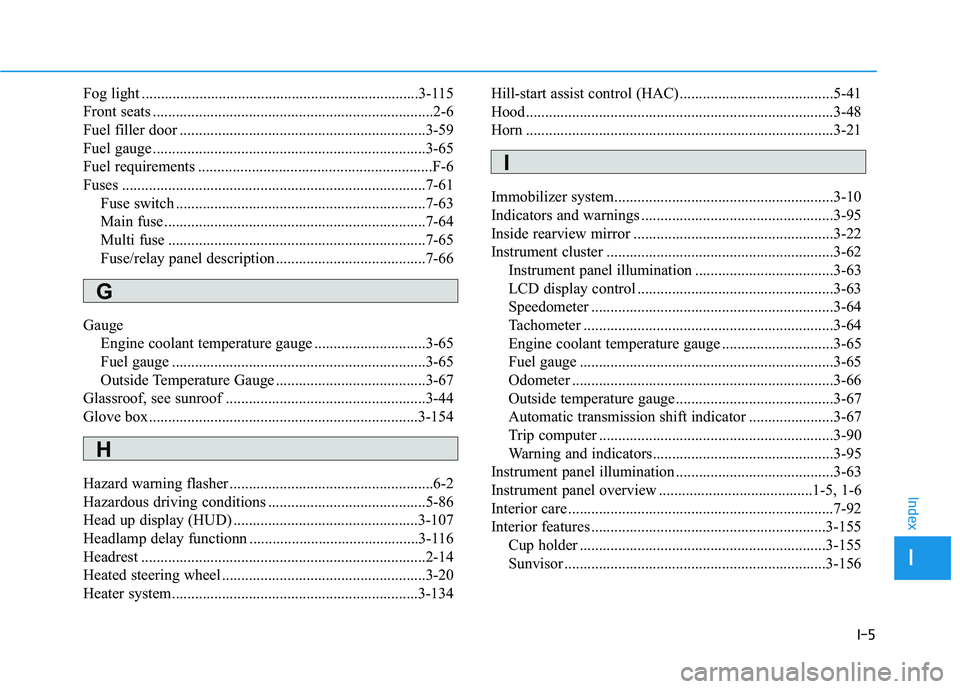
I-5
Fog light ........................................................................\
3-115
Front seats ........................................................................\
.2-6
Fuel filler door ................................................................3-59
Fuel gauge .......................................................................3\
-65
Fuel requirements .............................................................F-6
Fuses ........................................................................\
.......7-61Fuse switch .................................................................7-63
Main fuse ....................................................................7-64\
Multi fuse ...................................................................7-65
Fuse/relay panel description .......................................7-66
Gauge Engine coolant temperature gauge .............................3-65
Fuel gauge ..................................................................3-65
Outside Temperature Gauge .......................................3-67
Glassroof, see sunroof ....................................................3-44
Glove box......................................................................3-\
154
Hazard warning flasher .....................................................6-2
Hazardous driving conditions .........................................5-86
Head up display (HUD) ................................................3-107
Headlamp delay functionn ............................................3-116
Headrest ........................................................................\
..2-14
Heated steering wheel .....................................................3-20
Heater system................................................................3-134 Hill-start assist control (HAC)........................................5-41
Hood........................................................................\
........3-48
Horn ........................................................................\
........3-21
Immobilizer system.........................................................3-10
Indicators and warnings ..................................................3-95
Inside rearview mirror ....................................................3-22
Instrument cluster ...........................................................3-62
Instrument panel illumination ....................................3-63
LCD display control ...................................................3-63
Speedometer ...............................................................3-64
Tachometer .................................................................3-64
Engine coolant temperature gauge .............................3-65
Fuel gauge ..................................................................3-65
Odometer ....................................................................3-66\
Outside temperature gauge .........................................3-67
Automatic transmission shift indicator ......................3-67
Trip computer .............................................................3-90
Warning and indicators...............................................3-95
Instrument panel illumination .........................................3-63
Instrument panel overview ........................................1-5, 1-6
Interior care .....................................................................7-9\
2
Interior features .............................................................3-155 Cup holder ................................................................3-155
Sunvisor ....................................................................3-15\
6
I
Index
H
I
G